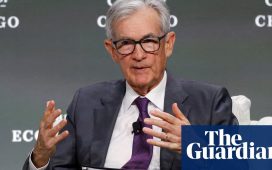Eurozone escapes recession
NEWSFLASH: The eurozone has escaped recession, and beaten forecasts for growth at the start of this year.
GDP across the eurozone expanded by 0.3% in January-March, statistics body Eurostat reports.
This means the eurozone’s shallow recession is over – its GDP shrank by 0.1% in both the third and fourth quarters of last year, which was a technical recession.
Eurozone growth has been held back by high interest rates, as the European Central Bank has battled inflation, while the cost of living crisis hit consumer spending.
Euro area GDP was lifted by stronger-than-expected growth in Germany, France, Italy and Spain (as we’ve been blogging since early this morning).
The wider European Union also grew by 0.3%.
Eurostat says:
Ireland (+1.1%) recorded the highest increase compared to the previous quarter, followed by Latvia, Lithuania and Hungary (all +0.8%).
Sweden (-0.1%) was the only Member State that recorded a decrease compared to the previous quarter. The year on year growth rates were positive for nine countries and negative for four.
France got the day off to a good start by reporting growth of 0.2% – which was hailed by its economy minister – before Spain posted a sizzling 0.7% growth. Germany then matched France, with 0.2% growth, while Italy expanded its GDP by 0.3%.
Key events
There’s not much financial market reaction the eurozone’s better-than-expected growth report.
The euro has gained about 0.06% to $1.0725 against the US dollar against this morning. It’s gained 0.2% against the pound, dragging sterling down to €1.1694.
Kathleen Brooks, research director at XTB, says:
The euro is back above $1.0720 vs. the US dollar after stronger than expected European GDP for Q1. Quarterly GDP rose by 0.3%, which was stronger than the 0.1% expected, and ‘bounced’ back from the -0.1% dip in growth registered in Q4.
Growth was broad-based across the currency bloc.
However, southern European economies continue to outperform their Northern counterparts.
But, this is unlikely to influence the European Central Bank, Brooks argues:
The interest rate futures market is still expecting the ECB to cut rates in June, due to the April inflation print, which was in line with expectations at 2.4%.
Core prices were slightly higher than expected at 2.7%, however this is still lower than the 2.9% recorded for March and the lowest level for nearly 2 years.
German and French CPI also registered 2.4% annual CPI growth, which is within touching distance of the ECB’s 2% target.
Today’s economic data out of the Eurozone point to an improving picture, reports Daniele Antonucci, chief investment officer at Quintet Private Bank:
Looking at the change relative to the corresponding quarter of the previous year, the beat versus consensus exceeds the highest prediction in the key polls of forecasters.
That’s the glass-half-full story, especially following the shallow recession the region has gone through in the second half of last year, though the caveat is that consumer spending across many European countries remains quite feeble.
The glass-half-empty story is that the pace of growth remains rather anaemic, with the forward-looking indicators pointing to moderately positive economic conditions. The contrast with the US, where domestic demand looks resilient and GDP growth appears to be re-accelerating, is stark.
This is important when prospects for the overall economy are seen in the context of the inflation data that is coming in. In the US, inflation has surprised to the upside lately. In the Eurozone, today’s data show a sideways trajectory for overall inflation, in line with expectations and lower in absolute terms than in the US.
ING: Eurozone benefitting from stable energy supply
Although 0.3% quarterly growth isn’t exactly stellar, it’s the eurozone’s strongest quarterly growth since the third quarter of 2022, early in Europe’s energy crisis.
Bert Colijn, ING’s senior eurozone economist, says the eurozone economy has clearly entered a better phase with economic recovery, low unemployment and more moderate inflation.
Lower energy prices, following the surge in oil and gas after Russia’s invasion of Ukraine in 2022, are helping the economy.
Colijn explains:
The economy is profiting from a more stable energy supply, with costs having substantially eased, resulting in lower inflation. Wage growth, in turn, has accelerated to make up for lost purchasing power, which is currently benefiting consumers.
We have yet to get the details, but judging from what’s happening in France, we see that household consumption led the way
CEBR: Eurozone has turned a corner
The eurozone is set to grow faster this year than in 2023, predicts Sam Miley, managing economist at the Centre for Economics and Business Research:
“This morning’s confirmation of quarterly growth in Q1 has put an end to a short-lived recession in the Eurozone, with the economy having turned a corner since the beginning of 2024.
Prospects are likely to improve further throughout the year, driven by the expectation of interest rate cuts. Further data released this morning showed that inflation has now stood within one percentage point of target for seven consecutive months, suggesting a suitable environment for the European Central Bank to consider adopting looser monetary policy.
Such policy changes will support growth this year. Cebr expects the Eurozone economy to expand by 0.6% in 2024, up from 2023’s growth figure of 0.4%.”
The eurozone economy is ‘moving along nicely’, says Neil Birrell, chief investment officer at Premier Miton Investors, following today’s GDP data.
“Inflation in the Eurozone came in as expected but is proving to be stickier than might have been hoped for, mirroring experiences elsewhere. The economy is moving along nicely though, meaning that, all in all, the ECB will be able to stay on track to be the first of the major central banks to push the “cut” button on interest rates, probably in June.
The prospects for the Eurozone are on the up, at a time when there is doubt creeping in for other economies’ prospects.”
More signs of recovery in the eurozone:
Q1 GDP +0.3% QoQ vs 0% Q4 2023
CPI is hotter than expected at 2.7%USD outperformance keeps EUR/USD below 1.0750 pic.twitter.com/xhnJ8FjRyj
— Fiona Cincotta City Index (@FionaCityIndex) April 30, 2024
Here’s Mohamed El-Erian, chief economic adviser at Allianz, on today’s eurozone data:
The just-released macro data for the #Eurozone include:
Headline inflation in line with the consensus forecast of 2.4%;
Slightly hotter-than-expected core #inflation at 2.7%; and
Slightly stronger #growth.
Together, they should not change policy expectations for the @ECB.— Mohamed A. El-Erian (@elerianm) April 30, 2024
Eurozone inflation sticks at 2.4%
Inflation across the eurozone was unchanged in April.
Eurostat reports that consumer price inflation was 2.4% per year, matching March’s reading.
Services inflation did slow, to 3.7% from 4% in March, but food, alcohol & tobacco inflation picked up to 2.8% from 2.6%.
Non-energy industrial goods prices rose by 0.9%, down from 1.1%.
Energy has less of a deflationary effect, though, with prices down by 0.6% year-on-year, from -1.8% in March.
Disappointingly, core inflation fell by less than expected. Inflation, stripping out energy, food, alcohol & tobacco, fell to 2.7% per year in April, down from 2.9%, but ahead of forecasts of a larger fall to 2.6%.
Eurozone escapes recession
NEWSFLASH: The eurozone has escaped recession, and beaten forecasts for growth at the start of this year.
GDP across the eurozone expanded by 0.3% in January-March, statistics body Eurostat reports.
This means the eurozone’s shallow recession is over – its GDP shrank by 0.1% in both the third and fourth quarters of last year, which was a technical recession.
Eurozone growth has been held back by high interest rates, as the European Central Bank has battled inflation, while the cost of living crisis hit consumer spending.
Euro area GDP was lifted by stronger-than-expected growth in Germany, France, Italy and Spain (as we’ve been blogging since early this morning).
The wider European Union also grew by 0.3%.
Eurostat says:
Ireland (+1.1%) recorded the highest increase compared to the previous quarter, followed by Latvia, Lithuania and Hungary (all +0.8%).
Sweden (-0.1%) was the only Member State that recorded a decrease compared to the previous quarter. The year on year growth rates were positive for nine countries and negative for four.
France got the day off to a good start by reporting growth of 0.2% – which was hailed by its economy minister – before Spain posted a sizzling 0.7% growth. Germany then matched France, with 0.2% growth, while Italy expanded its GDP by 0.3%.
UK mortgage approvals hit 18-month high
In the UK, mortgage approvals have hit their highest level since the chaos of Liz Truss’s mini-budget.
New Bank of England data show that lenders approved 61,300 in March, up from 60,500 in February, which is the highest total since September 2022.
There was also some relief for borrowers; the ‘effective’ interest rate – which is the actual interest paid – on newly drawn mortgages decreased by 17 basis points, to 4.73% in March.
In March 2024 there was a lot of movement on the ladder as the effective interest rate decreased by 17 basis points, to 4.73%. 61,300 moved on it, up 800 on Feb 24, making it the highest number of net approvals since Sep 2022. While others stepped off; net approvals for… pic.twitter.com/NJa1fP9Nrk
— Emma Fildes (@emmafildes) April 30, 2024
Getting back to eurozone GDP….and Portugal has grown as a steady pace at the start of this year.
Portugal’s GDP grew by 0.7% in Q1 2024, the same rate as in Q4 2023, and was 1.4% larger than a year ago.
Earlier this month, Portugal’s new centre-right government predicted the economy would grow 1.5% in 2024. It is planning to roll out tax cuts for the middle class in an effort to spur growth and investment.
German sportswear brand Adidas has benefited from a sales pick-up in Europe and China, that helped it overcome a slowdown in the US.
Adidas hs reported that sales in Europe increased by 14% in the last quarter, while they grew by 8% in Greater China, but fell by 4% in North America.
Adidas CEO Bjørn Gulden reported that sales, gross margin, and operating profit were all better than expected, and warned that “markets are still volatile and not easy”.
Gulden adds:
We now look forward to celebrate the great sports events like the Euro 2024, Copa América, the Olympics and Paralympics. It is a great year for sports – let us all enjoy it!”








